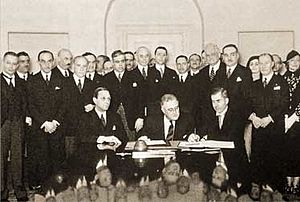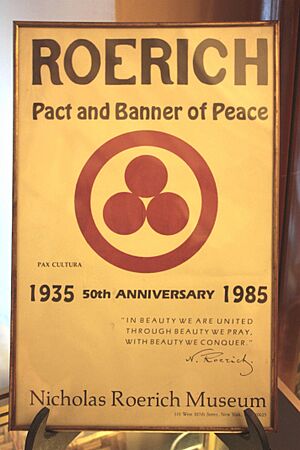Roerich’s Pact facts for kids

The Roerich Pact is an important agreement about protecting art, science buildings, and old historical places. It was signed by 21 countries on April 15, 1935, at the White House in Washington, D.C. By 1990, ten countries had officially agreed to follow it, including Brazil, Mexico, and the United States. The pact started working on August 26, 1935. It is also known as Pax Cultura, which means "Cultural Peace." The main idea of the Roerich Pact is that protecting culture is always more important than anything else, even during wars.
Contents
Who Was Nicholas Roerich?
Nicholas Roerich (1874-1947) was a Russian painter and thinker. He started the idea of protecting cultural treasures around the world. He wanted to create "Peace of Civilizations."
Nicholas Roerich was born in Saint Petersburg, Russia. He became a very successful artist. One of his paintings was even bought by the Russian Emperor, Nicholas II of Russia.
After 1918, Roerich left Russia. In 1923, a museum dedicated to his work opened in New York City. Later, Roerich moved to the Kulu Valley in the Himachal Pradesh mountains, part of the Himalayas. He passed away there in 1947.
In 1929, Nicholas Roerich worked with a professor named Giorge Chklaver to write the first plan for this international agreement. This plan was all about keeping cultural items safe.
The President of the United States, Franklin D. Roosevelt, helped a lot to get all the countries in North and South America to sign this agreement. President Roosevelt even had a statue of Roerich in his private rooms.
The Roerich Pact later became the basis for a bigger United Nations agreement in 1954. This UN agreement was called the "International Convention for Protection of Cultural Values in the Event of Armed Conflict." However, some of Roerich's original ideas, like putting cultural safety before military needs, are still not fully used in international law.
Key Moments for the Roerich Pact
- 1904: Nicholas Roerich first thought of protecting art and science achievements.
- 1914: During World War I, Roerich suggested his idea to the Russian government.
- 1929: Roerich asked countries to create an agreement to protect world treasures.
- 1930: The Roerich Pact plan was approved by the League of Nations Museums Committee. Groups were formed in New York and Paris to support the pact.
- 1931: An international group for the pact was started in Belgium. The first big meeting about the Roerich Pact happened in Bruges, Belgium.
- 1932: The second international meeting for the Roerich Pact took place in Bruges.
- 1933: The third international meeting for the Roerich Pact was held in Washington, USA.
- 1935: On April 15, the Roerich Pact was officially signed at the White House by 21 countries.
- 1948: The government of India approved the Roerich Pact.
- 1954: The UN's "International Convention for Protection of Cultural Values in the Event of Armed Conflict" was created. It used the Roerich Pact as its main idea.
- 1956: The UN agreement from 1954 officially began.
What is the Banner of Peace?
The Roerich Pact suggested a special flag to show which places were protected. This flag was called the Banner of Peace. It was a white flag with a red circle and three red dots inside it. This symbol meant that the past, present, and future are all connected in a never-ending circle. Nicholas Roerich often included this Banner of Peace symbol in his paintings.
Why the Roerich Pact Still Matters Today
The Roerich Pact is more than just an old agreement. It has important ideas about how a country should work. It suggests that a country's budget should spend money on culture, art, and education. It even says these cultural expenses should be more than military expenses. This means that protecting cultural items is seen as more important than military needs. Roerich believed that taking care of future generations was a key reason for countries to exist.
When the Roerich Pact was signed, U.S. President Franklin D. Roosevelt said that it was a step towards keeping modern civilization safe. He felt it had a deeper meaning than just the words in the agreement. The Roerich Pact was a big step in creating new rules for protecting culture. Its main idea is that a country's most important job is to protect its national culture. Many of the Roerich Pact's ideas are still not fully used in international law. Some people believe that the 21st century is the right time to make these ideas a reality.
Related pages
Images for kids
-
The Banner of Peace from the "Mir" space station presented to the Speaker of Indian Parliament, Sri Somnath Chatterjee. From left: Sergei Zalyotin, Viktor Afanasyev, Sri Somnath Chatterjee, and Yuli Vorontsov.
See also
 In Spanish: Pacto Roerich para niños
In Spanish: Pacto Roerich para niños







